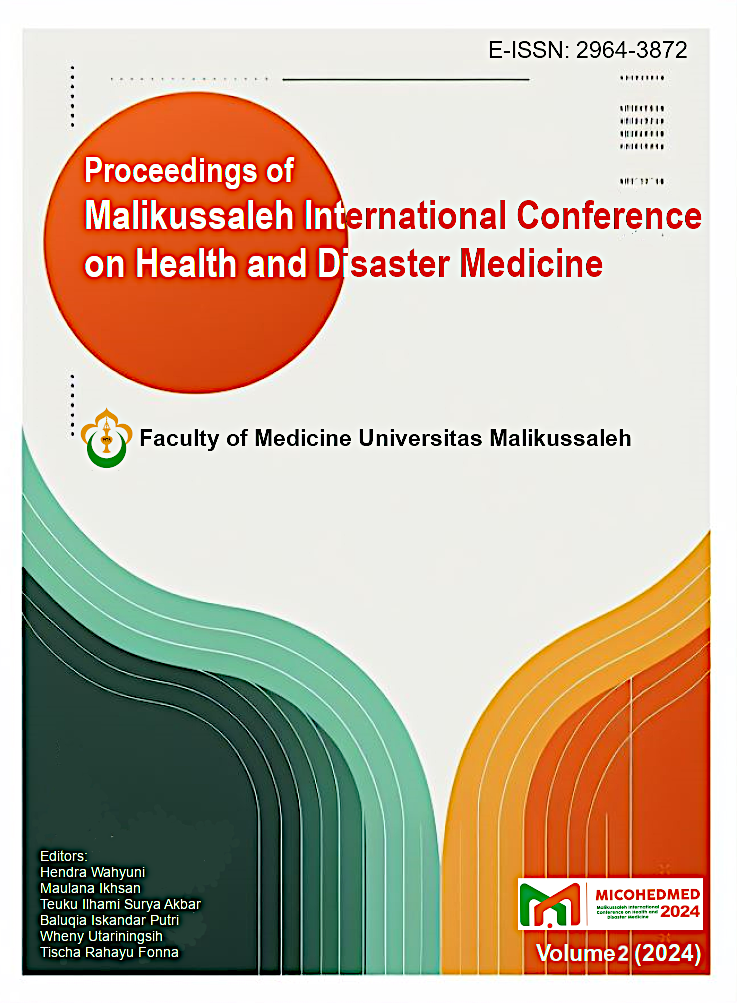Characteristics and Treatment of Pneumonia Patients at Cut Meutia General Hospital North Aceh in 2022
DOI:
https://doi.org/10.29103/micohedmed.v2i.1200Keywords:
Pneumonia, infection, characteristics, treatmentAbstract
Pneumonia, an acute respiratory infection affecting the lungs, manifests as inflammation of lung parenchyma and can be caused by various infectious agents such as bacteria, fungi, viruses, and chemical substances. Pneumonia is a global health issue due to its high mortality rates, not only in developing countries but also in developed nations. There are 450 million recorded cases of pneumonia each year, resulting in approximately 4 million deaths. Length of stay for pneumonia patient is crucial as it correlates with the severity of the patient's condition and the associated costs or patient insurance. The general objective of this research is to determine the characteristics and treatment of the patient with the length of stay of pneumonia patients’ hospitalization at Cut Meutia General Hospital in North Aceh in 2022. This study employs a descriptive approach with a cross-sectional method, by collecting medical record data from 107 samples aged >18 years through total sampling. The research findings indicate that the majority of hospitalized pneumonia patients are aged > 60 years, categorized as elderly, male, with comorbidities, receiving non-ICU treatment. Mostly undergoing monotherapy antibiotics, and the majority of patients are discharged with improvement, with length of stay for < 7 days.
References
1. Marrie TJ. Acute bronchitis and community-acquired pneumonia. Fishman AP. Fishman’s PulmonaryDiseases and Disorders New York: Mc Graw Hill Book Company.2010.
2. WHO. Pneumonia in children. 2022.
3. Levison ME. Pneumonia, including necrotizing pulmonary infections (lung abscess). Harrisons Principles of Internal Medicine. 2017. (2):1475–84.
4. Irawan R, Reviono, Harsini. Korelasi kadar copeptin dan skor PSI dengan waktu terapi sulih dari antibiotik intravena ke oral dan lama rawat pneumonia komunitas. Jurnal Respirologi Indonesia. 2019. (39):1
5. Rudan I, Boschi-Pinto C, Biloglav Z, dkk. Epidemiology and etiology of childhood pneumonia. Bulletin WHO. 2018. 86:408-416B.
6. Jokinen C, Heiskanen L, Juvonen H, dkk. Incidence of community-acquired pneumonia in the population of four municipalities in eastern Finland. Am J Epidemiol. 2016 (9):977–88.
7. Ruuskanen O, Lahti E, Jennings LC, dkk. Viral pneumonia. The Lancet. 2018. 377:1264–75.
8. Badan Penelitian Dan Pengembangan Kesehatan. Laporan Nasional RISKESDAS. 2018; 80-6
9. Yudhianto K. Laporan Provinsi Aceh, RISKESDAS Aceh 2018. 2018;74-9
10. DINKES Aceh. Profil Kesehatan Aceh Tahun 2017. Banda Aceh. 2018; 20-3
11. PDPI. Pneumonia komunitas: Pedoman diagnosis dan penatalaksanaan. Edisi II Jakarta: Badan Penerbit FKUI. 2014. (22)1608-10
12. Price SA, Wilson LM. Patofisiologi konsep klinis proses-proses penyakit. Jakarta: Egc. 2016;4(2):127–8.
13. Gannon CJ, Pasquale M, Tracy JK, dkk. Male gender is associated with increased risk for postinjury pneumonia. Shock. 2017. 21(5):410–4.
14. Neupane B, Walter SD, Krueger P, dkk. Predictors of inhospital mortality and re-hospitalization in older adults with community-acquired pneumonia: a prospective cohort study. BMC Geriatr. 2018. 10:1–10.
15. Gold DR, Rotnitzky A, Damokosh AI, dkk. Race and gender differences in respiratory illness prevalence and their relationship to environmental exposures in children 7 to 14 years of age. American Review of Respiratory Disease. 148:10.
16. Hardiana I, Laksmitawati DR, Ramadaniati HU. Evaluasi penggunaan antibiotika pada pasien pneumonia komunitas di instalasi rawat inap RSPAD Gatot Subroto. Majalah Farmasi Dan Farmakologi. 2021;25(1):1–6.
17. Metlay JP, Waterer GW, Long AC, Anzueto A, dkk. Diagnosis and treatment of adults with community-acquired pneumonia. An official clinical practice guideline of the American Thoracic Society and Infectious Diseases Society of America. Am J Respir Crit Care Med. 2019. 200(7):45–67.
18. Hori S, Yamamoto Y, Ushida K, dkk. Impact of Frailty Risk on Oral Intake and Length of Hospital Stay in Older Patients with Pneumonia: A Historical Cohort Study. J Clin Med. 2023 Jan 1;12(1).
19. Rafiudeen R. “A study of clinical and etiological profile of community acquired pneumonia with special reference to atypical pneumonia.”: Rajiv Gandhi University of Health Sciences; 2012.(3):12
20. Aljufri AQ, Yasin NM, Wahyono D. Rasionalitas Terapi Antibiotik Empiris Pada Pasien Pneumonia di Instalasi Rawat Inap RSUP Dr. Kariadi Semarang. Majalah Farmaseutik. 2021 Jan 7;17(1):89.
21. Farida Y, Putri VW, Hanafi M, Herdianti NS. Profil Pasien dan Penggunaan Antibiotik pada Kasus Community-Acquired Pneumonia Rawat Inap di Rumah Sakit Akademik wilayah Sukoharjo. JPSCR: Journal of Pharmaceutical Science and Clinical Research. 2020 Oct 27;5(2):151.
22. Lopardo GD, Fridman D, Raimondo E, Albornoz H, dkk. Incidence rate of community-acquired pneumonia in adults: a population-based prospective active surveillance study in three cities in South America. BMJ Open. 2018;8(4):6.
23. Marsono Y. Evaluasi Penggunaan Antibiotik Pada Pasien Pneumonia Dengan Metode Gyssens Di Instalasi Rawat Inap Rumah Sakit Umum Daerah Dokter Moewardi Surakarta Tahun 2013. [surakarta]: Universitas Muhammadiyah Surakarta; 2015;(1):9
24. Henig O, Kaye KS. Bacterial pneumonia in older adults. Infectious Disease Clinics. 2017;31(4):689–713.
25. Hardiana I, Ratih Laksmitawati D, Utami Ramadaniati H, dkk. Evaluasi penggunaan antibiotika pada pasien pneumonia komunitas di instalasi rawat inap rspad Gatot Subroto. Original Article MFF. 2021;25(1):1–6.
26. Sari EF, Rumende CM, Harimurti K. Faktor–Faktor yang Berhubungan dengan Diagnosis Pneumonia pada Pasien Usia Lanjut. Jurnal Penyakit Dalam Indonesia. 2017 Jan 27;3(4):183.
27. Cillóniz C, Cardozo C, García-Vidal C. Epidemiology, pathophysiology, and microbiology of community-acquired pneumonia. Ann Res Hosp. 2018;2(1):1–11.
28. Halim S. Faktor-faktor prediksi mortalitas pada pasien hospital acquired pneumonia. Universitas Indonesia; 2013.(11):14
29. Ulfa Cf, Supadmi W, Perwitasari Da. Hubungan ketepatan peresepan antibiotik dengan metode gyssens dengan perbaikan klinis pasien rawat inap pneumonia komunitas. 2021; (4):23
30. Pradipta IS, Febrina E, Ridwan MH, Ratnawati R. Identifikasi pola penggunaan antibiotik sebagai upaya pengendalian resistensi antibiotik. Indonesian Journal of Clinical Pharmacy. 2012;1(1):16–24.
31. Syahniar R, Akbar AM, Kharisma DS, dkk. Comparison between monotherapy and combination therapy among inpatients with community-acquired pneumonia. Scientific Journal of Pharmacy. 2021;17(1):13–14.
32. Lukitasari N, Radji M, Rianti A. Analisa Perbandingan Monoterapi dengan Dualterapi Antibiotik Empiris terhadap Outcome pada Pasien Community Acquired Pneumonia (CAP) di IGD RSUP Fatmawati Jakarta. Jurnal Sains Farmasi & Klinis. 2019 Aug 29;6(2):147.
33. Setiadi F, Kumala S, Utami R H, Subhan A. Analisis faktor-faktor yang mempengaruhi outcome terapi pasien pneumonia di rumah sakit umum pusat fatmawati jakarta. Healthy Tadulako Journal . 2019;5(3):18–28.
Downloads
Published
How to Cite
Issue
Section
License
Copyright (c) 2024 Muhammad Kautsar, Cut Khairunnisa

This work is licensed under a Creative Commons Attribution-ShareAlike 4.0 International License.
n order for Proceedings of Malikussaleh International Conference on Health and Disaster Medicine (MICOHEDMED) to publish and disseminate research articles, we need non-exclusive publishing rights (transfered from author(s) to publisher). This is determined by a publishing agreement between the Author(s) and Proceedings of Malikussaleh International Conference on Health and Disaster Medicine (MICOHEDMED). This agreement deals with the transfer or license of the copyright of publishing to Proceedings of Malikussaleh International Conference on Health and Disaster Medicine (MICOHEDMED), while Authors still retain significant rights to use and share their own published articles. Proceedings of Malikussaleh International Conference on Health and Disaster Medicine (MICOHEDMED) supports the need for authors to share, disseminate and maximize the impact of their research and these rights, in any databases.
As a proceeding Author, you have rights for a large range of uses of your article, including use by your employing institute or company. These Author rights can be exercised without the need to obtain specific permission. Authors publishing in Proceedings of Malikussaleh International Conference on Health and Disaster Medicine (MICOHEDMED) proceedings have wide rights to use their works for teaching and scholarly purposes without needing to seek permission, including:
- use for classroom teaching by Author or Author's institution and presentation at a meeting or conference and distributing copies to attendees;
- use for internal training by author's company;
- distribution to colleagues for their reseearch use;
- use in a subsequent compilation of the author's works;
- inclusion in a thesis or dissertation;
- reuse of portions or extracts from the article in other works (with full acknowledgement of final article);
- preparation of derivative works (other than commercial purposes) (with full acknowledgement of final article);
- voluntary posting on open web sites operated by author or author’s institution for scholarly purposes,
(but it should follow the open access license of Creative Common CC-by-SA License).
Authors/Readers/Third Parties can read, print and download, redistribute or republish the article (e.g. display in a repository), translate the article, download for text and data mining purposes, reuse portions or extracts from the article in other works, sell or re-use for commercial purposes, remix, transform, or build upon the material, they must distribute their contributions under the same license as the original Creative Commons Attribution-ShareAlike (CC BY-SA).




